BEE FLORA AND POLLINATION OF CROPS
Bee visits plants for its food, nectar and pollen. This floral fidelity of bees is due to their preference for nectars having sugar contents and pollens with higher nutritive values. Besides getting food for the bees as a result of their visit pollinate a number of crops.
Qualities of honeybees which make them good pollinators
- Body covered with hairs and has structural adaptation for carrying nectar and pollen.
- Bees do not injure the plants
- Adult and larva feed on nectar and pollen which is available in plenty
- Considered as superior pollinators, since store pollen and nectar for future use
- No diapauses is observed and needs pollen throughout the year
- Body size and proboscis length is very much suitable for many crops
- Pollinate wide variety of crops
- Forage in extreme weather conditions also
Effect of bee pollination on crop
- It increases yield in terms of seed yield and fruit yield in many crops
- It improves quality of fruits and seeds
- Bee pollination increases oil content of seeds in sunflower
- Bee pollination is a must in some self incompatible crops for seed set
Crops benefited by bee pollination
Fruits and nuts: Almond, apple, apricot, peach, strawberry, citrus and litchi
Vegetable and Vegetable seed crops: Cabbage, cauliflower, carrot, coriander, cucumber, melon, onion, pumpkin, radish and turnip.
Oil seed crops: Sunflower, niger, rape seed, mustard, safflower, gingelly.
Forage seed crops: Lucerne, clover.
Yield increase due to bee pollination
Crop |
Per cent yield increase |
Mustard
Sunflower
Cotton
Lucerne
Onion
Apple |
43
32-48
17-19
112
93
44 |
Scope of beekeeping for pollination in India: Total area of bee dependant crops in India is around 50 million hectare. One hundred and fifty million colonies are needed to meet this, at the rate of 3 colonies per hectare. In India at present, there are only 1.2 million colonies exist. Hence there is a wide scope for expansion of bee keeping for pollination in India.
Management of bees for pollination
- Place hives very near the field source to save bee's energy
- Migrate colonies near field at 10 per cent flowering
- Place colonies at 3/ha for Italian bee and 5/ha for Indian honey bee
- The colonies should have 5 to 6 frame strength of bees, with sealed brood and young mated queen
- Allow sufficient space for pollen and honey storage
Pollination by bees - case studies with selected crops
1. Sunflower: It is a cross-pollinated crop. The pollen of the plant cannot fertilize ovary of same plant. Pollen source should be from different plant. Hence, honey bees acts as important agents for pollination in sunflower. In sunflower, yield increases even up to 600 per cent due to bee pollination. It improves quality and quantity of seeds. Oil content also increases by 6.5 per cent in seeds. To achieve this it requires five strong C. indica colonies or three A. mellifera colonies. Mostly irrigated crop is preferred by bees.
2. Cucurbitaceous vegetables: Cucurbits are monoecious with staminate and pistillate flowers in same plant. Due to bee pollination fruit set increases up to 30 to 100 per cent.
3. Alfalfa or lucerne: These plants have tubular flowers with 5 petals joined at base. They posses one large standard petal, 2 smaller petals on sides and 2 keel petals holding staminal column. When bee sits on a keel petal, stamina column strikes against standard petal resulting in shattering of pollen. This is called tripping. Seed set occurs only if bee sits to trips the flowers.
4. Coriander: In coriander yield increases up to 187 per cent due to pollination.
5. Cardamom: It is an important commercial crop depending on bees for pollination. Here yield increases up to 21 to 37 per cent.
6. Gingelly: Another oilseed crop where bee pollination causes 25 per cent increase in yield.
7. Apple: In apple seed set occurs only if it is pollinated by bees. Fruit is formed only around the seeds. If improper seed set occurs fruit shape is lopsided resulting in decreased market value.
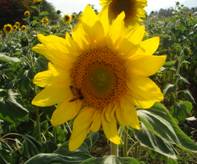
|
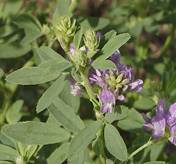
|
Sunflower |
Alfalfa or Lucerne |
The following are some of the important plants either wild or cultivated visited by bees for collecting nectar or pollen or both.
Other fruit Trees
All kinds of citrus, litchi, peach, apple, guava, jamun, date palm, apricot, quince, pear, almond, plum, loquat, phalsa, and cashew.
 |
Honey bee on acid lime flower |
Cultivated field crops
Pigeon pea, lentils, clovers, Lucerne, mustard, rape, linseed, sesame, gingelly, buck-wheat, Cambodia, safflower, millet and sunflower
Vegetables
All cucurbitaceous plants, okra, beans, turnip, radish, onion, brinjal, and sweet potato.
Timber trees
Neem, Cassia fistula, Acacia, Albizzia spp., Kachnar (Bauhinia purpurea), eucalyptus, sandle-wood, raintree, wild cherry.
Natural and ornamental flowers
Cosmos, shoe flower, Golden rod, Cup & saucer, Tecoma stans, zinnia, coral creeper (Antigonon leptopus), rose, rangoon creeper, aster, wild rose (kuja), hydrangea, violet, portulaca, poinsettia, honey suckle, corn flower, coreopsis, dandelion etc.
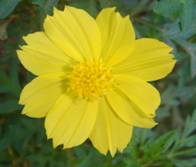
|
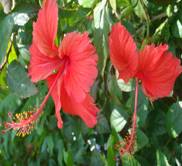
|
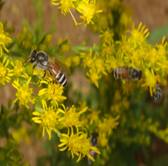
|
Cosmos |
Hibiscus |
Golden rod |

|
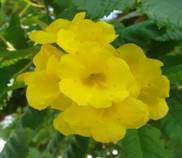
|
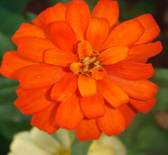
|
Aster |
Tecoma stans |
Zinnia |
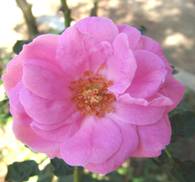
|
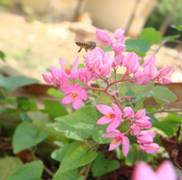
|
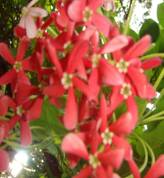
|
Edward rose |
Coral creeper |
Rangoon creeper |
It is now apparent that most of the pulses and oilseeds, fruits and orchard crops including vegetables heavily depend on bees for their pollination. This is also true for seed production of vegetables like onion, cabbage, cauliflower, tabacco, sunnhemp, alfa alfa and clovers. The number of colonies of honeybees required per hectare very much depends on the strength of foraging bees in the colony, the crops and prevailing weather conditions. The optimum number of colonies of average strength may range from 3 to 9 colonies per hectare, since the bees usually forage within a radius of about 1 to 2 km to harvest their nectar and pollen loads, and then return to their own hive.
|












